Vivid Audio G1 Spirit (Voted one of BEST speakers ever)
R440,000.00
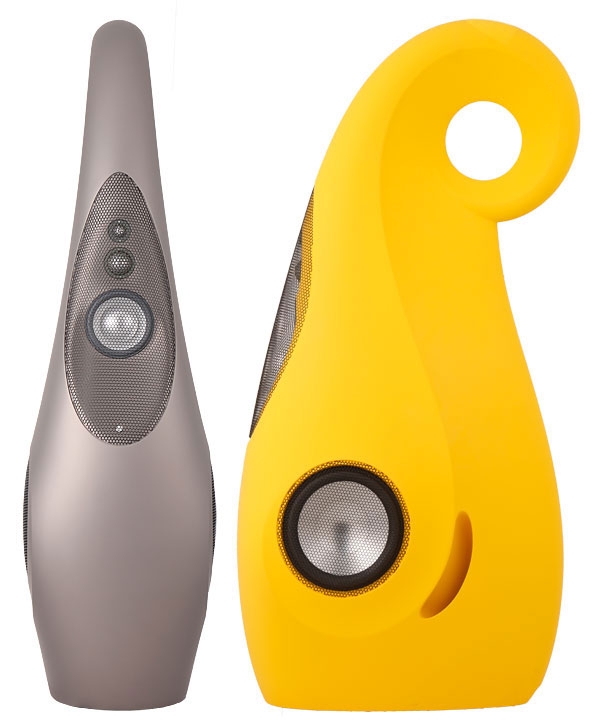
It’s been more than seven years since the late Wes Phillips reviewed Vivid Audio’s top-of-the-line loudspeaker, the Giya G1, for Stereophile, and since then the speaker has been seriously revised. At first glance you still notice the sui generis form; closer inspection reveals fundamental changes that make it, in most respects, an entirely new speaker.The Giya G1 Spirit is slightly shorter and wider than the Giya G1—as if the latter’s top had been gently pushed down a few inches and bulged out its bottom half. This change in shape was needed to accommodate the entirely new and larger C225-100 low-frequency driver, which I’ll get to shortly. Other changes are an entirely new lower-midrange driver, a new external crossover, and a hefty increase in price: from $65,000 to $93,000/pair (add a bit more for special finishes) (footnote 1).
I was first exposed to the original Giya G1 in a top-floor suite of the Mirage Hotel in Las Vegas, many Consumer Electronics Shows ago, and it was love at first listen. The room was large by hotel standards, and carefully set up. We listened to a short playlist, and it set a high bar for show sound for years to come. In short, as Wes noted in 2010, the original Giya G1 was and still is something special.
In 2017, a few months after arrangements for a review of the Giya G1 Spirit were made, then-US distributor Philip O’Hanlon rented a van and drove the review samples up the California coast, from San Juan Capistrano to our place near Paso Robles. He’d warned me ahead of time about the size and weight of the Spirits’ wooden crates, and I’d asked a couple members of the local audio club to be at the house when he arrived.
Wise move. The total weight of each speaker and its 6′ by 3′ by 2′ crate is over 250 lbs. A word of praise here for the most excellent job Vivid has done in figuring out how to protect these weighty speakers, and make it easy to get them into your room and upright. The crates are built to last, with places to grab hold, and rubber wheels on one edge for easy maneuvering. We opened the crates outside, in the driveway, and as we tipped the first speaker out of its sarcophagus, we saw it had a board bolted to its bottom, with handles! We used these to carry each speaker into place, where we laid it on its side and removed the board. Each Spirit’s top swirl is sturdy enough to use as a handle, and most of its weight is at the bottom—they were surprisingly easy to set upright and move around.
It’s what’s inside that counts
The Giya G1 Spirit is a classic example of form following function. It’s a four-way, five-driver system, and each of the two midrange and single high-frequency drive-units is enclosed in its own appropriately sized and logarithmically tapered subenclosure. These look like long cones, and each is optimized for its driver’s operating bandwidth and hidden inside the main cabinet. All you see are the diaphragms out front, and three bolts at the back, for tensioning the internal cones to keep them from vibrating.
The two opposed woofers—which, like all Vivid drivers, feature aluminum-alloy diaphragms, and which I measured as 11″ in diameter (although Vivid specs them at 8.9″)—fire from both sides at the bottom of the cabinet, their backsides connected with an internal brace that neatly cancels any reaction between the woofers and the cabinet. Immediately behind each woofer, at the rear of and molded into the sidewall, is a port roughly 10″ by 2″. The woofers’ rather large tapered-cone enclosure comprises the entire interior of the cabinet, including the large curl on top—it’s the woofer chamber’s cone, wrapping around so it doesn’t stick straight up.
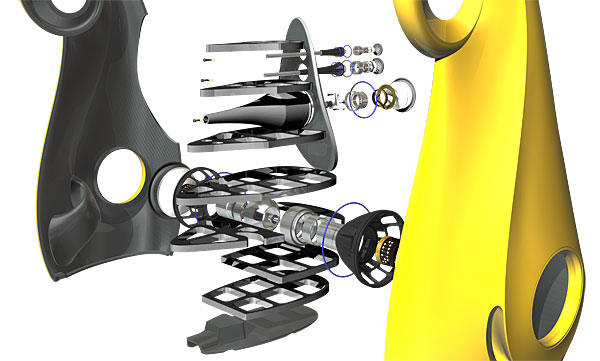
The three mid- and high-frequency drivers are covered by a single sheer-mesh grille of rigid metal that magnetically clings to the front of the speaker. Each woofer also has its own circular grille. It’s an ingenious design, and they never rattled or came loose. To remove a grille, firmly pry one edge with the fingertips until it pops off. I tried listening with the grilles on and off, and concluded that they didn’t harm the sound in any way. I left them on the entire time the speakers were here.
Wes Phillips’s review of the Giya G1 covered Laurence Dickie’s design theory and engineering well enough that I’ll stick to highlighting the updates in the Spirit. Vivid says that redesigning the cabinet and pulling the crossover out to occupy a separate box has made the speaker substantially less resonant, and made room for two more carbon-skinned braces inside. The completely new woofer’s wider, longer voice-coil required the wider cabinet and bigger ports, and, at 600W, it can handle twice the power of the original G1’s woofer.
The completely redesigned C125-75 midbass driver has a magnet whose diameter increases from 2″ to 3″ (50 to 75mm), and has been moved from the driver’s rear to a position where it now surrounds the voice-coil. Vivid says that the project began as an investigation into the reoptimization of the form of the cone-and-dome assembly, but with the addition of carbon-fiber rings: “In the same way that applying a peripheral carbon fibre ring to the D50 dome changes the optimum shape and doubles the frequency of the first break up, so the new profile of C125-75 with carbon rings has resulted in a dramatic improvement taking the first break up from 4.3kHz to 10.5kHz.”
The shiny, Pearl-finished pair O’Hanlon brought with him looked like two perfectly tufted peaks of stiffly whipped cream carefully dropped onto the carpet. Vivid describes the material these speakers are made of as “glass reinforced balsa cored sandwich composite,” and it’s a result of designer Dickie’s philosophy of light, rigid materials that push resonances higher in frequency, where they’re less obtrusive. You’d think this would make for a light speaker, but alas, everything inside still adds up to one heavy product. I used Vivid’s spikes (six per speaker; other, non-spikey footer options are included) to lock the speakers securely to the wooden subfloor under the carpet.
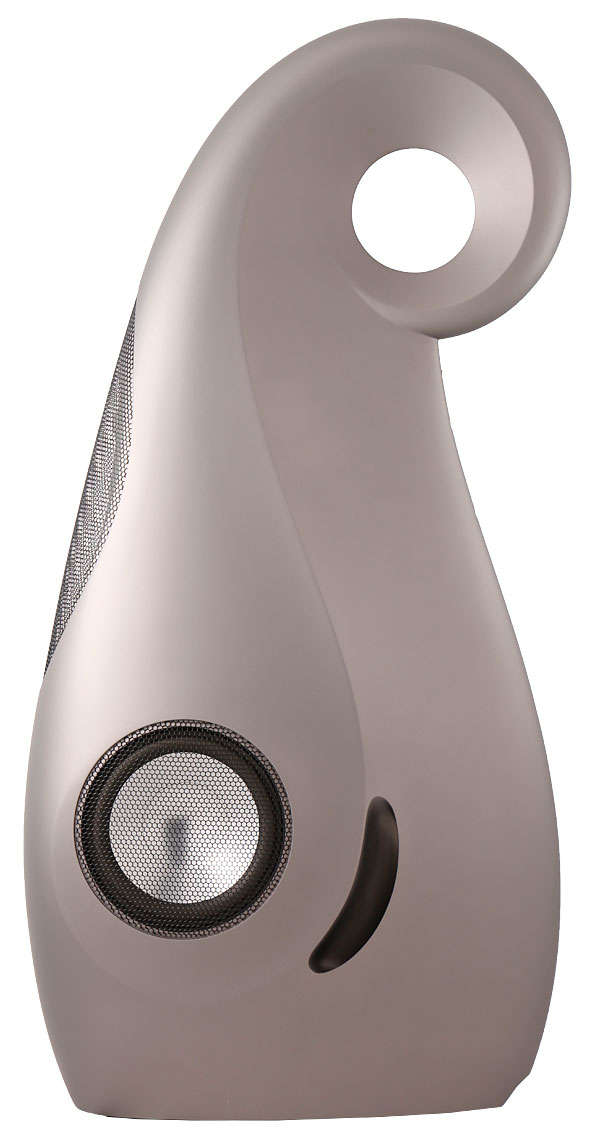
The standard finishes are Piano (black) and Pearl (white). Some Vivid ads feature custom colors such as banana yellow, and I’ve seen red as well. The finish is so luxuriant and appealing that I wanted to stroke and touch them, maybe even lick them. I wasn’t sure what we’d think when they were set up in the house, but the first impression was very positive, and they grew on us more over time. Of the dozens of visitors of all genders and ages who listened to them here, only one objected to their unconventional appearance. And he was an artist at that!
It’s a setup
The Giya G1’s external crossover, new in the Spirit revision, permits both the optimization of the internal chamber of the speaker and custom active or passive crossover alternatives, and now the first order of business was to configure it.
Each speaker’s crossover comes housed in its own hefty, gloss-black enclosure measuring 16″ wide by 4″ high by 11″ deep, weighing 13.2 lbs, and resting flat on spiked or flat feet (both are included). At one end of the box is an 18″-long, ¾”-diameter cable that looks like a short, black cow’s tail. Fitted to its end is a hefty, round, professional-grade NL8 multi-pin connector that goes straight into the speaker’s matching jack. O’Hanlon told me that longer and/or custom cables of your choice can be had, and I’m guessing you can order the crossover box in flaming orange. At the other end of the box are two sets of binding posts, for biwiring to your amp. If you don’t want to biwire (I do, however), jumper straps are included.
Connecting the crossover cable to the speaker is tricky—cable and connector fit into a hidden pocket in the base of the speaker cabinet. It helps to have someone tip the speaker forward to get access to this pocket and lock the cable in place—there’s not much working room. But unlike most speakers, once the G1 Spirit is hooked up, its back is free of hanging wires and makes for a very clean installation. And if you cut a hole in the floor directly under each speaker and run its cable straight down (somehow hiding the crossover under the floor), the speakers would look perfectly wireless.
We placed the Spirits approximately where my baseline references, MartinLogan’s Prodigy electrostatics, had been in my largish listening space, and O’Hanlon began by using the title track of Shelby Lynne’s Just a Little Lovin’ (CD, Lost Highway B0009789-2) to distance the speakers from the front and side walls. He used the left channel of the recording, one speaker at a time, listening for the sound of the bass to make sure it met his approval at the listening position. He then had me sit down and close my eyes while he walked in front of the speaker from the left wall, repeating the phrase “This is a test” until I said it sounded most natural. He marked that point on the floor with tape. That point then became the starting position from the wall for the left speaker. He then repeated this for the right speaker, with some minor tuning to follow, until we were both satisfied.
After all that, in the weeks following O’Hanlon’s visit, I continued to fine-tune the Spirits’ positions and toe-in angles. Bass was the way I like it. Tonality was spot-on and very realistic, but I was looking for the optimal balance between razor-sharp depiction and soundstage size and depth. My quest ended with a magnificently big sound but not the tightest imaging. Instruments and voices still hung in space as they should, but each was more rounded and slightly more diffuse than the images produced by my MartinLogans electrostatics. This was not necessarily a bad thing.
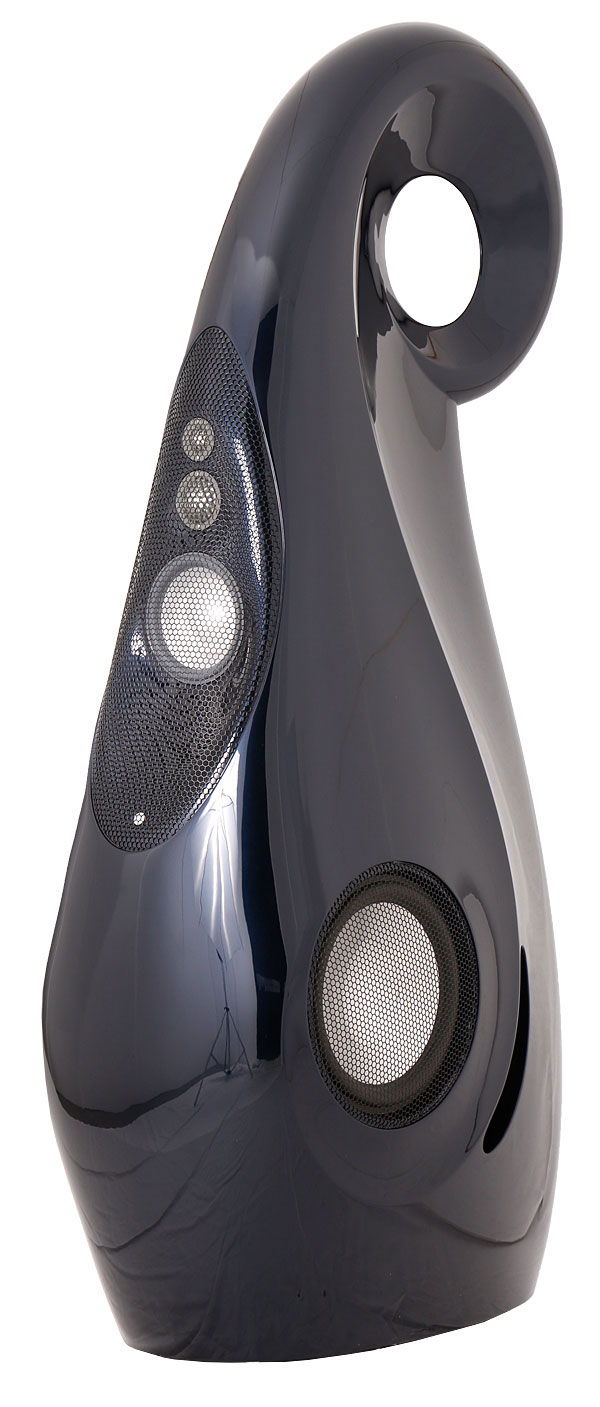
Lending an ear or two
Chelsea Williams’ Boomerang (CD rip, Blue élan) begins with a haze of hammered dulcimers before a panoramic orchestra of sounds falls in behind her commanding voice—a rich, honeyed voice that draws the listener directly in, and greatly reminds me of Americana-flecked favorite First Aid Kit. It’s love at first listen—the entire album is a hidden gem of 2017. Through the Giya G1 Spirits there was deep bass and layers of acoustic and electric instruments, and Williams’s well-recorded voice was locked in place, front and center, wonderfully rendered.
As a result of my setting up the Spirits to suit my preferences in sound, the size and depth of this recording were slightly bigger than life. But in this case, mo’ Chelsea mo’ betta! It was almost the perfect album to show off what the Vivids got so right: natural, even tonality all across the midrange, with a cohesive soundstage from left to right and from front to back. There was no spittiness, no artificial sheen or edge on anything. No matter how loud I turned them up, the Spirits hung everything together and refused to act out.
“Afterglow,” from Lydia Ainsworth’s Darling of the Afterglow (16/44.1k file, Arbutus), eventually became the first track I played when anyone wanted to hear the Spirits. Sitting somewhere between Kate Bush, Peter Gabriel, and Lana Del Rey, “Afterglow” launches with deep bass pulses and droning voices, before Ainsworth’s carefully multitracked voice hovers in the room as the bottom end drops right out. A pal has described this track as a series of low-frequency test tones with voice. It works for me. (If you’re curious, watch the video on YouTube.)
This was the Giya G1 Spirit’s sweet spot: big, full-range, dynamic sound, with a hint of extra charm on top. When I played this track loud, people wanted to hear it still louder; and as I pushed the volume up, there was no brightness or glare. “Afterglow” is that rare track that’s simultaneously huge and intimate, and the Spirits presented everything in thrilling detail and depth. The music may not be your cup of tea, but I wish every reader could hear this track through the Spirits, and get the pure musical rush they could deliver with a recording so accomplished and rich.
I also played “Afterglow” when the audio club visited, and several members whipped out their phones to take photos of the album cover, for future reference. Demo track of the year? After that meeting, member Kris Vardas, himself a promising amateur speaker designer, wrote on our club’s Meetup.com page: “Listened to my audio system for the first time since hearing the Vivid G1s at Jon’s house. In comparison, my floorstanders sound like small bookshelf speakers.” I think he exaggerates, but it does touch on why the Spirits are so seductive.
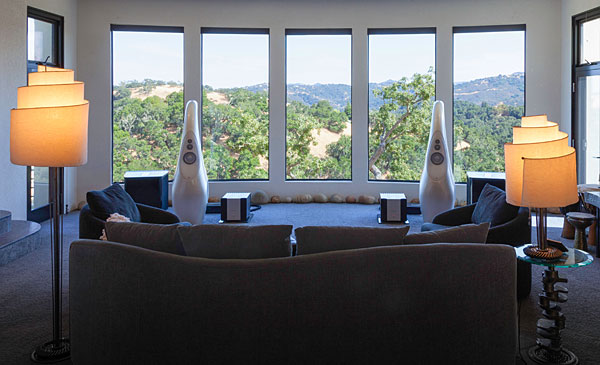
Anyone who’s visited my listening room knows we love BIG BASS around these parts, and normally run our two powered subwoofers all the time. But I turned them off while we were setting up the Spirits, then never turned them back on. Though the very bottom octave was a bit shy by powered-sub standards, there was no need to add the big boys back in—across the board, the Spirits laid down a solid, room-shaking foundation that was both musical and tight. Okay, so maybe Dickie snuck in a little extra bottom end down there in the lower to midbass? Here’s where the external crossover would let you add some active electronics, so you could fine-tune to taste.
We ran all the usual big-bottom suspects, from Gentlemen’s Dub Club to Dub for Daze to Dub Vibes to Dubblestandart, and on to electronic, trip-hop, Mahler, and everything in between. Always rewarding, always satisfying. I’ll put it this way: If you really don’t like bass (I’m guessing there are a few of you out there), these are not the speakers for you. The Vivids gave great weight and impact to rock and large-scale classical music alike. Yet when I scaled my playlist back to more acoustic fare, such as Yusuf/Cat Stevens’s excellent new album, The Laughing Apple (24/44.1k file, Verve Decca Crossover), the bottom end got out of the way to let the supple midrange do its thing, floating his voice in space and bringing it to life.
Classical piano, small chamber, and full orchestral arrangements were all in the mix the last couple months, and though they all sounded wonderful through the Spirit, the Vivid’s attributes shone brighter with modern music, rock in particular. With a chamber orchestra given a lively recording, such as Rachel Podger’s masterful take on J.S. Bach’s violin concertos with Brecon Baroque (SACD/CD, Channel Classics 30910), the entire ensemble took on a lovely liquid quality, the trade-off being that the instruments themselves were not as distinctly layered in space as I’ve heard through other speakers. With this many musicians on stage, this layering becomes more critical.
The Vivids’ sound remained smooth and consistent when I listened vertically or horizontally off axis, with a slight top-end rolloff the farther I moved to one side. The sweet spot was of generous size—images held steady as I moved a few feet to either side of the center seat, or even stood up. I also found the Spirits could maintain a uniform sonic signature, including the bass, no matter where I set the volume—something that isn’t often tested, but that I’ve found humbles many otherwise promising products.
Robert Plant’s new album, Carry Fire (24/96 file, Nonesuch), is what I call bang-and-strum music: hand drums and drum kits keep the pulse while guitars and other, more exotic stringed instruments layer the chords. Above it all, Plant croons in his plaintive boy-lost-in-the-woods voice. Carry Fire is not a great recording, but it turned out to be a good album for evaluating various playback levels: at low volumes, Plant’s voice retained all its characteristics in the same proportion as at live levels. With some speakers, vocal overtones and richness push forward or recede, depending on the volume. Not here.
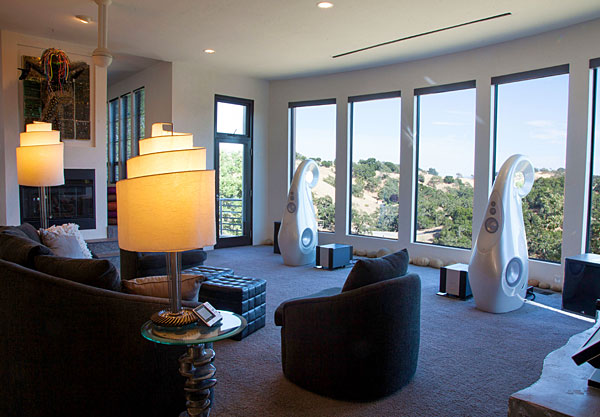
Compared to what
In recent months I’ve heard plenty of pricey competing speakers set up to sound fantastic in a variety of settings: the Wilson Audio Specialties’ Alexx, YG Acoustics’ Sonja 1.3, various Magicos, and, for much less money, Rockport Technologies’ Avior II and Vienna Acoustics’ The Music, to name a few favorites.
Vivid’s Giya G1 Spirit fits easily in this rarified company. If I had to draw a general conclusion, I’d say that, of the speakers mentioned above, the Spirits were more easygoing on top, while a tad less exacting in imaging and the layering of soundstage depth. But the Spirit’s dynamic impact at loud levels was better than anything I’ve heard. The YGAs easily better the Vivids in precise holographic imaging—but I’ve never heard the Sonja 1.3s rock out like the Giya G1 Spirits.
Comparing the Vivids to MartinLogan’s superb Masterpiece Renaissance ESL 15As, which spent several happy months in my room earlier this year—along with their self-powered 12″ woofers—it was readily apparent that the Vivids had more bottom end. The MLs do have an active bass-calibration system to bring things in line, while the Vivids’ bass reproduction is subject to placement more than anything else—and we’d placed the Spirits where the bass was standing proud! But while the MLs had plenty of openness and detail and tight imaging, they could never render loud rock as dynamically and as easy to listen to as could the Vivids.
Conclusions
Vivid’s Giya G1 Spirits could rock, and often inspired me to dive all in. And with a great recording, the closer to realistic levels I pushed them, the better everything sounded. At the same time, simple vocal recordings played softly, late at night, sounded sublime. A real treasure, that.
The Giya G1 Spirit is like a rich, robust cup of coffee with a bit of milk and sugar. Is that extra bit of sweetness a distraction? There were times when I might have preferred my music rendered straight, with all details intact. But with most real-world recordings this was rarely a problem—and with dodgy recordings, a little sugar goes a long way.
As if on cue as I wrote this up, Stereophile reader “blang11” commented, on the online reprint of John Atkinson’s review of KEF’s Reference 5 loudspeaker: “I struggle to remember the last speaker review I read in Stereophile that described the sound as a bit too sweet. I recall the majority are either neutral (yay!) or overly bright or the tweeter is simply a few [dB] too high in level. As someone who has recently moved into a room that’s a bit bright, I now recognize that a bit of sweetness can be just what the doctor ordered, especially for those whose recordings aren’t impeccable.”
That’s the Spirit!
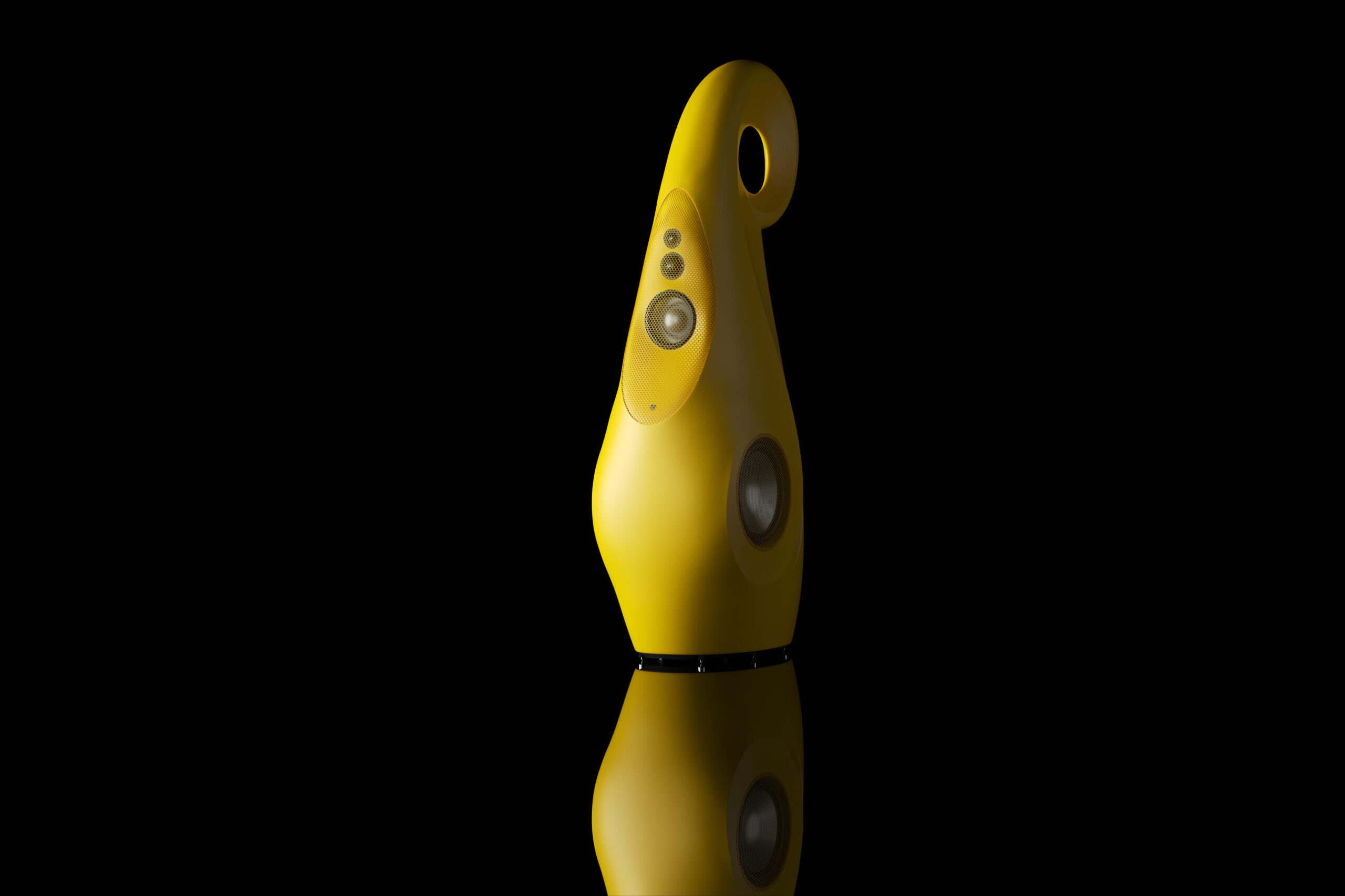
I managed to get away to Greece in late July last year, just as it was reaching Greek temperatures in the UK, and enjoyed two weeks of proper ‘scorchio’ weather. I noticed how much hotter the towns were (even in the shade) than the less densely populated areas, especially those without buildings. This is largely because the roads and buildings soak up heat and then slowly release it over the day. This is what high-mass cabinets do, albeit at a different frequency; they store the energy that comes from the drive units and release it over time, rather more time than it takes for the signal to be produced by the drivers. The heavier the loudspeaker cabinet, the more extreme this can get even if heavy speakers do have a solidity in the bass that quite appealing for the same reason.
With most wooden cabinets the energy is directly radiated by the panels of the box to some extent, the better the bracing the lower the radiation appears to be the rule. Vivid takes a wholly different approach to controlling radiation by making the cabinet as stiff and light as possible. The Giya G1 Spirit is a large speaker that stands just over five foot high and has a volume of 180 litres but it weighs less than 70 kilos. A Bowers & Wilkins 802, by comparison, is more than a foot shorter and weighs nearly 90 kilos.
Two skins
The Vivid Giya cabinets are made from two skins of vacuum-infused glass-reinforced composite, a sophisticated variant on fibre glass, with end grain balsa between the two skins to provide stiffness. A few manufacturers make bass drivers in a sandwich arrangement like this but they use foam as the filling; a speaker cabinet needs something a bit more solid. The distinctive shape of Giya is not a whim of the Vivid styling department but a genuine instance of form following function. The tubular ring at the top represents the end of the inverted horn that absorbs energy from the two bass drivers on either side of the cabinet. This is very similar to the tapered tube concept that Vivid designer Laurence Dickie created for Bowers & Wilkins in the original Nautilus loudspeaker, which has subsequently found its way into the 800 series models.
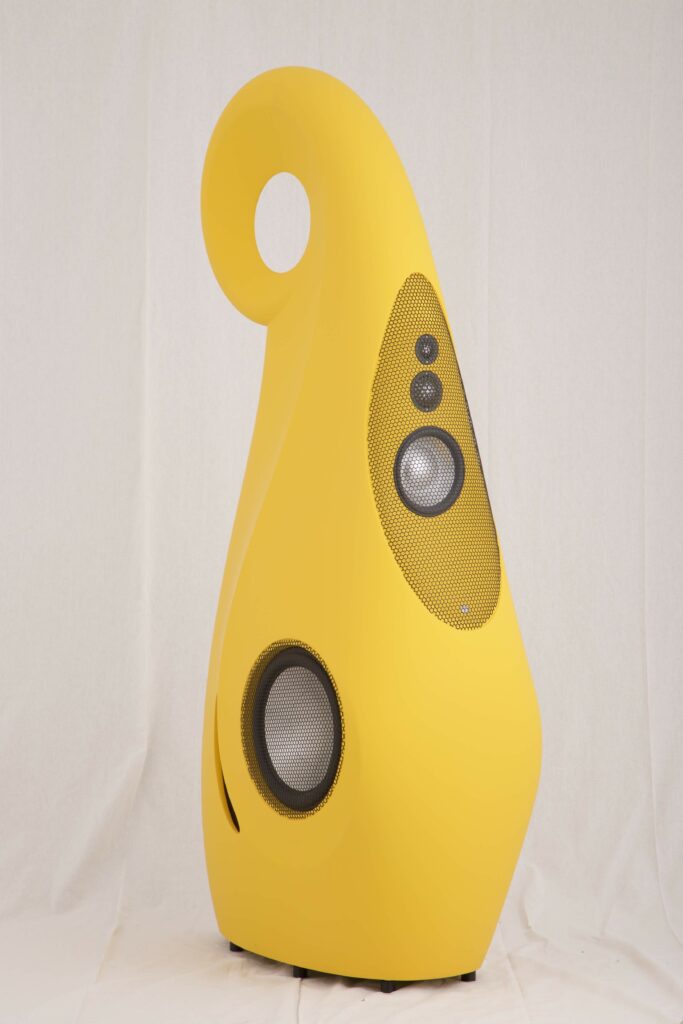
In Vivid loudspeakers, this tapered tube system is used with all the drivers. You can see where those for the tweeter, upper- and lower-midrange drivers terminate on the back of the cabinet where small hex bolts are visible. The bass drivers which produce the most energy and are thus most likely to vibrate the cabinet, are not fixed to it in the usual way. Instead they are physically braced against one another and held in place with a compliant mounting where the chassis meets the cabinet, this is an approach found in some of the better subwoofers, and I note, a concept speaker that Monitor Audio showed in Munich High-End 2022, and means that the bass system is solidly anchored with minimal risk of transmitting energy into the ‘box’.
This is still a reflex-loaded loudspeaker however; it’s just that like the bass drivers there are two reflex ports that look a bit like gills and sit opposite one another either side of the cabinet behind the bass drivers. This arrangement is used in order to balance the ports and let the bass system breathe evenly.
Breaking up the chain
Vivid develops and makes its own drive unts. This is the only way that Dickie could use domes that are not conventional hemispheres, instead they have a catenary shape which is the shape a chain forms when it’s hung between two posts. This shape was chosen because its break up point is notably higher than a regular dome even before you add the carbon fibre reinforcing ring to its perimeter. If Vivid’s measurements are to be believed, and Dickie is a first-rate engineer, the catenary shape has such clear advantages over regular domes that one wonders why no one else uses them, perhaps there’s a patent at work here.
The lower midrange is perhaps the most unusual driver on the Giya G1 Spirit, it has a large oblate sphere (doughnut shaped) central dome and very steep cone sides. The large central dome indicates that this 125mm driver has a 75mm voice coil, which is a rare ratio. Like the domes above it this driver has a carbon fibre reinforcement ring at the base of the dome, an arrangement not seen on any other driver including those in the Vivid range.
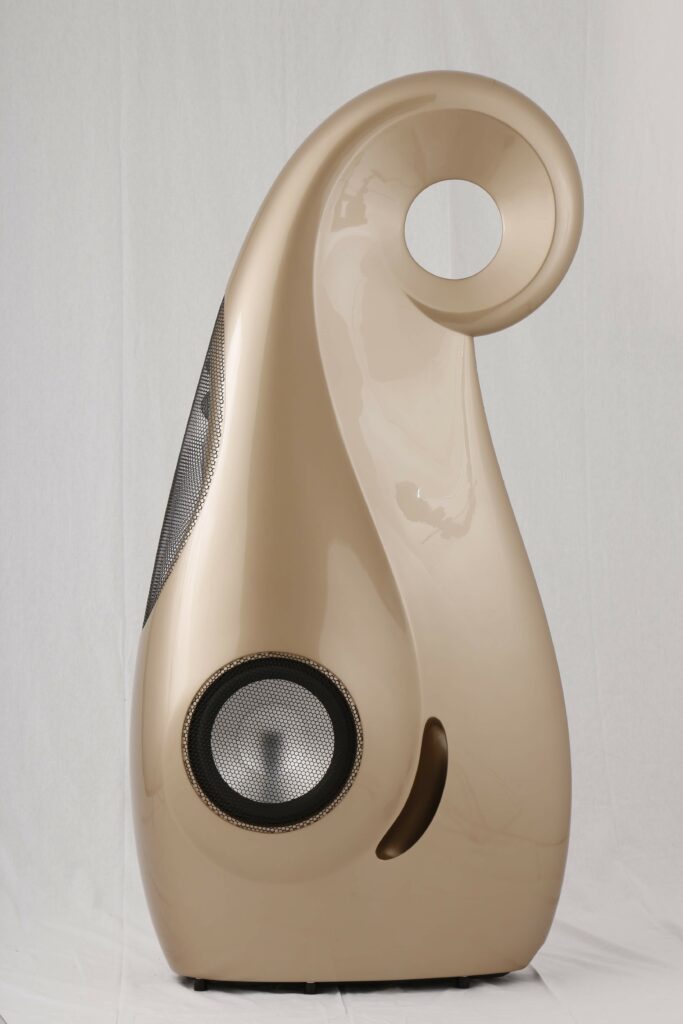
The G1 Spirit is available with a conventional onboard crossover or a separate outboard one. The latter comes in a relatively conventional rectilinear case made of the same material as the speaker, so it’s good and shiny with chamfered corners. Connection to the loudspeaker is via an umbilical that fixes right underneath the speaker, with the onboard crossover the cable terminals are also underneath the speaker. This makes for a very neat appearance but requires that the speaker be laid on its side in order to make the connections, which is true in both onboard and outboard crossovers. The advantage of the latter is easy speaker cable connection and less vibration for the crossover components to cope with, however it was originally conceived to allow the G1 Spirit to be actively driven, and this has been done with electronics from Linn, Devialet and Trinnov in the past.
Clean living
The sonic character of this loudspeaker is very distinct, inasmuch as it appears to have virtually none of its own. And yet because this is so much more obviously the case than with most other loudspeakers it really stands out. The first thing that hits you is that nothing hits you except the music, that is there are no sharp edges, no sense of grain or distortion. Dickie disagrees with that last word and prefers the term ‘coloration’ because that is the correct term, however the Giya G1 Spirit doesn’t just sound as though it has an even tonal response, it sounds as though it doesn’t have the sharp edges found with the vast majority of loudspeakers. If anything it is very much like an electrostatic, it has the same smoothness and ease as the best examples of the genre but this is combined with the low end power and dynamics of a reflex design.
It’s a speaker that warrants high quality and well matched amplification, I was able to offer this to an extent but not the full extent so suspect that even with the incredible results I got there is more to be heard from these extraordinary loudspeakers. Nonetheless having them in the system proved to be a totally revelatory experience the like of which I have rarely had the pleasure of. There is a good variety of very open sounding loudspeakers on the market today, the more advanced designers take into account the fact that you can’t get an even response in a normal room unless the sound that hits the side walls, floor and ceiling has the same balance as the direct sound from drivers to your ears. This wide dispersion approach requires great driver design and a cabinet that doesn’t hinder energy coming off those drivers in all directions, the Giya G1 Spirit cabinet is devoid of sharp edges so the signal has nothing to reflect off as it exits the speaker. This reduces sensitivity to an extent but also reduces coloration to a much greater extent, this speaker’s sensitivity is actually quite high at 92dB (2.83 VRMS at 1m) and its nominal impedance a relatively easy six Ohms. So Vivid has managed to keep coloration down without sacrificing ease of drive which is a rare achievement in itself.
Wide Dispersion
The wide dispersion is presumably one reason why this speaker sounds so relaxed, not the primary reason but a factor. It’s also why the image scale changes with every piece of music played, in fact everything about every recording played through the Giya G1 Spirit seems to be revealed. Give them a good acoustic recording such as Chasing the Dragon’s Mendelsohnn Octets and the sense of being there is more than palpable, it’s totally convincing. You get the openness of the high ceiling at the Henry Wood Hall where the recording was made and you get the timbre of the eight instruments layered and dare I say it, vivid, in front of you. What also struck me about this and many other pieces of music is how well the Vivids track level, that is the volume level of individual voices and instruments relative to one another in a given mix. Described as micro dynamics this is an area where the ultra low noise (because there is so little cabinet vibration) of these speakers puts them into another league. It allows the listener to follow and appreciate different performers within a group and to hear the way that different elements of a mix have been treated.
If that all sounds rather dry what it boils down to is a degree of transparency that is exceptional, and that means that more of the musical signal gets into the room without being colored or distorted. With Mari Samuelsen’s first solo album Mari [DG] it means that a large group of musicians appears in the room by some means of magic, the degree of realism is positively uncanny. This is a spectacular recording but just how spectacular became a lot clearer with the big Vivids, I’ve never heard string tone that’s so natural nor had a sense of the scale and nature of a studio acoustic that was so well reproduced. It makes the music she creates that much more powerful and moving, and it makes me realise that the Rega P10 turntable is even better than I thought it was, and I was pretty impressed in the first place.
With less natural recordings in the form of Frank Zappa’s live You Can’t Do That On Stage Anymore [Zappa Music] releases, you can hear how he has built up these tracks using snippets from different performances, a guitar break here, a voice there. You can hear the joins but this does not get in the way of enjoying the brilliance of the music, Zappa had standards that not even his highly rehearsed bands could always live up to and by using the best bits spliced together he was able to construct the near as possible perfect concerts for those of us unable to attend the real thing. Having a loudspeaker that is capable of delivering that music at a suitable volume without any sense of effort and all of the bandwidth required is a very special experience that gets you as close as you can to being there.
Not a cartoon
The bass on the G1 Spirit is not obvious, that is like the rest of the bandwidth it doesn’t have sharpened leading edges that define it a bit like a cartoon. Rather the bass is three dimensional, it’s got depth and weight and moves with effortless speed. Essentially it’s extremely natural, and just as extended and powerful as the signal demands, so if that signal emanates from a synth or electric bass it can be very muscular indeed. But if it’s a piano or double bass there is more texture and depth of tone, more variety and colour. Whatever the source it’s very juicy and appealing and always bang on time.
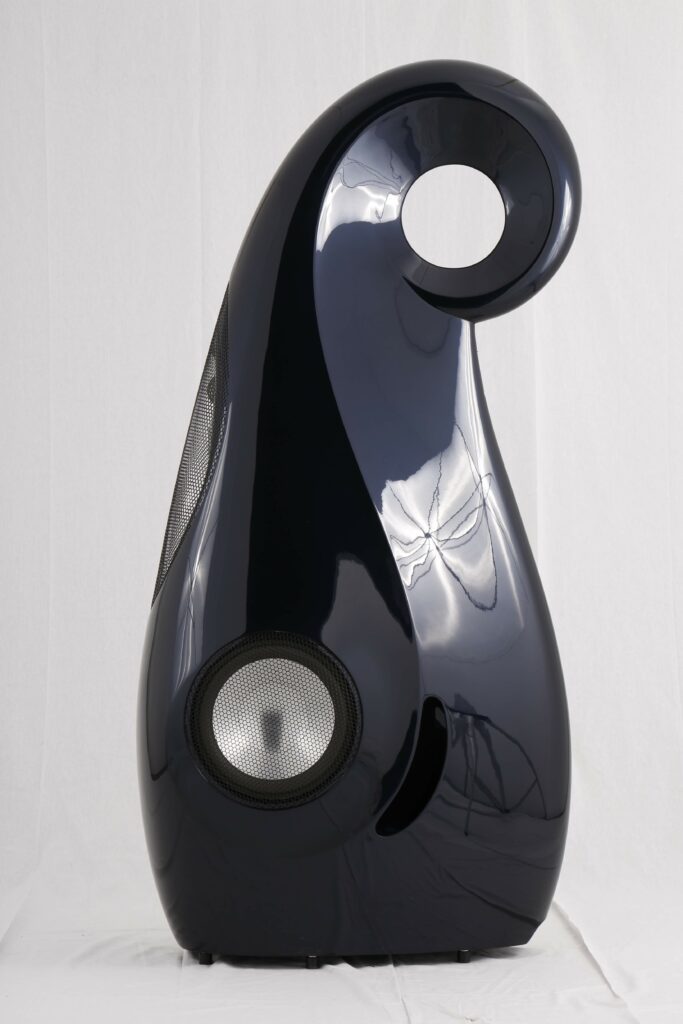
The Vivid Giya G1 Spirit is an exceptional loudspeaker, thanks to the way that its drivers and cabinet have been executed it doesn’t have the problems associated with 99.9% of dynamic loudspeakers. Instead you get sound that’s as exciting, powerful and beautiful as the recording permits, and many of them permit an awful lot of all three. It’s a speaker that I could all too easily live with right up to the point where enthusiasm needed to be summoned for another loudspeaker review. It’s not a speaker for reviewers, it’s a speaker for music lovers who don’t have to make comparisons.
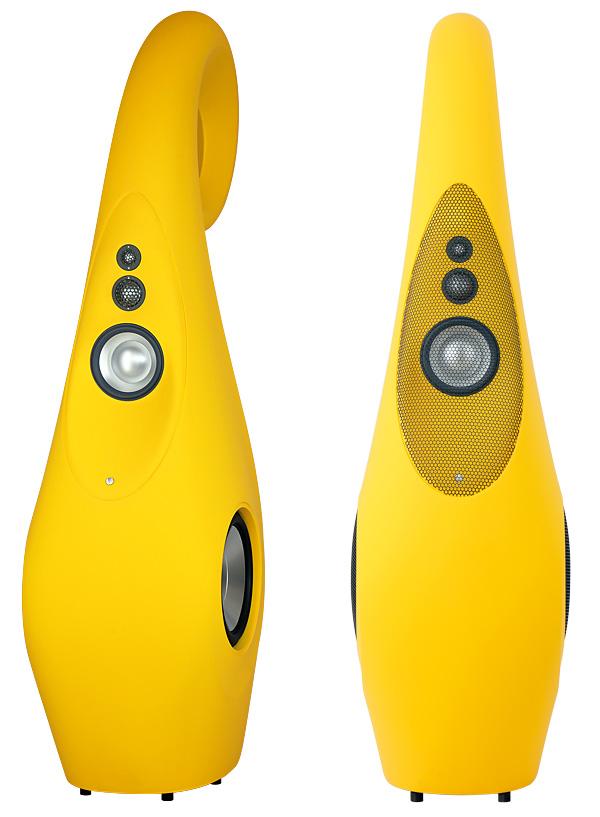
 It may not look as outrageous as the iconic B&W Nautilus, but this is its younger, and arguably superior offspringWhen B&W introduced the Nautilus in 1993 it created what is surely the most iconic loudspeaker any of us will ever see. Its ‘snail on steroids’ look projected it on to countless magazine pages around the world and gave B&W the kind of PR boost company CEOs dream of. Only it wasn’t a PR man that contrived the Nautilus, it was B&W’s then senior design engineer Laurence Dickie. And though it looked like something created by H R Giger for the set of Alien, the Nautilus was actually an exemplar of the Bauhaus diktat that form follows function. It looked that way because it needed to be that way.
It may not look as outrageous as the iconic B&W Nautilus, but this is its younger, and arguably superior offspringWhen B&W introduced the Nautilus in 1993 it created what is surely the most iconic loudspeaker any of us will ever see. Its ‘snail on steroids’ look projected it on to countless magazine pages around the world and gave B&W the kind of PR boost company CEOs dream of. Only it wasn’t a PR man that contrived the Nautilus, it was B&W’s then senior design engineer Laurence Dickie. And though it looked like something created by H R Giger for the set of Alien, the Nautilus was actually an exemplar of the Bauhaus diktat that form follows function. It looked that way because it needed to be that way.
As much as the Nautilus was a star for B&W, its looks were considered too outlandish. So in spinning off its Nautilus technology into the 800 Nautilus series, B&W went for more conventional looks, abandoning the curved and tapered transmission line behind the bass unit that so defined the original aesthetic. But the spirit of a full-on Nautilus didn’t die.
Keeping The Spirit
Laurence Dickie, who left B&W in 1997 to work in pro audio, became engineering director of Vivid Audio in 2004 and picked up where he left off, culminating in the current flagship Giya G1 Spirit reviewed here. It’s yours for £64k in black or pearl white gloss, or £68k with external crossover, plus another £3950 for custom colours. It doesn’t replace the existing Giya G1 but slots in above it, and while it looks very similar it’s actually deeper and shorter to maintain the same internal volume while lowering the tweeter axis.
Visually distinct from the Nautilus, the Giya G1 Spirit is still another example of form following function. Forget slab-side box cabinets that are prone to panel resonances and undesirable diffraction effects: this is a curved, organic form designed to be both structurally stiff and to avoid secondary radiation from right-angle baffle edges. Stiffness is further enhanced by the cabinet’s internally-braced sandwich of GRP skins with a balsa wood core.
Keynote Speaker
Reminiscent in side view of a treble clef, the G1 Spirit lacks the G3’s and G4’s externally visible exponential horn absorbers behind the two dome drivers because, being taller, it is able to accommodate them out of sight within the cabinet. But they are still there, as are larger equivalents for the lower-mid cone driver and twin bass drivers, the latter of which runs upwards through the cabinet’s top loop, before curling itself up like a snail shell, just like that of the Nautilus.
Unlike the Nautilus, however, which had a closed-box bass section, the G1 Spirit is reflex loaded and by combining this with a tapered rear absorber, realises the benefits of both [see interview]. Reduced LF distortion is promised along with improved LF output capability and an improved trade-off of sensitivity and bass extension (courtesy of reflex loading) plus effective suppression of internal air volume resonances (thanks to the absorber).
As in the original G1, twin bass drivers, with a brace between their magnets, are used to provide force cancellation, and this principle is carried over to the reflected banana-shaped reflex ports arrayed on either side of the cabinet. All Vivid’s drivers are designed and assembled in-house using bought-in diaphragms and voice coils. With the current 225mm bass units, now with larger 100mm voice coils, Dickie has incorporated a lesson learnt in his days working with pro speakers, which he found delivered tighter-sounding bass as a result of being ‘over-shoved’, ie, having greater motor force than necessary for a classically optimal bass alignment.
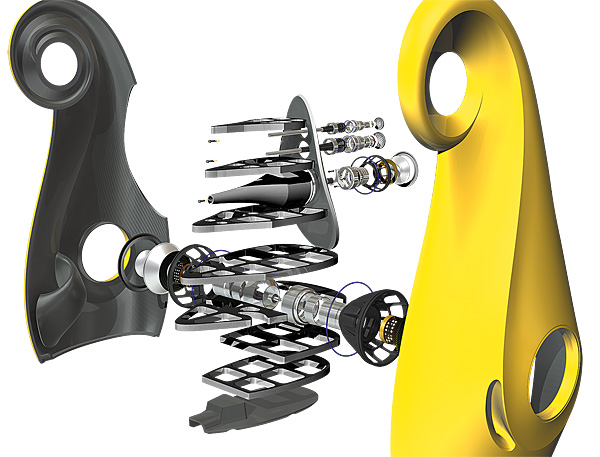
Like B&W’s Nautilus the G1 Spirit is a four-way design, the twin bass drivers handing over to an improved 125mm cone lower-mid unit, 50mm dome upper-mid and 26mm dome tweeter at 220Hz, 800Hz and 3.5kHz respectively. Fitment of a larger, 75mm voice coil to the lower-mid driver has increased power handling, and carbon fibre composite stiffening rings added to the neck and outer diameter of the diaphragm have raised the first breakup frequency from 4.3kHz to 10.5kHz.
In the two dome drivers, carbon fibre rings complement the unique dome shape. Whereas dome diaphragms typically take the form of a spherical cap, so that their cross-section is an arc of a circle, Vivid’s finite element optimisation process identified the optimal dome cross-section to be a catenary – the shape that a slack chain adopts under the force of gravity. In the larger dome, as an example, the first breakup mode occurs above 21kHz.
All three upper drivers also have rear-mounted exponential horn absorbers. Their annular motor assemblies use radially-polarised magnets (as opposed to the more usual, and cheaper, axially-polarised type) to provide large-diameter vents behind the dome diaphragms. The motor’s smaller external diameter also allows the drivers to be closely spaced, ensuring good vertical off-axis behaviour through crossover.
The external crossover option (supplied for review) might suggest it’s intended to further improve sound quality, by removing vibration-sensitive passive crossover components from the cabinet. But Dickie says he has compared internal and external crossovers and hears no difference. Instead, with the passive crossover removed from the cabinet, there’s always the possibility of an active (third party) crossover being used with the Giya G1 Spirit. Connection from the external crossover is via a thick, captive cable, terminated in a twist-to-lock connector that locates in the speaker base.
![]() Open Sesame
Open Sesame
This is a dramatic sounding design and no mistake, but not in the sense of embellishment or other added colour. Rather, the Giya G1 Spirit is one of the few loudspeakers able to convey the majesty and scale of whatever music you choose to play – with all its delicious texture and detail intact. So, despite having a multitude of drive units, there’s no sense of listening to several speakers in one as you’re offered a seamless sound from bottom to top.
Every aspect of a recording issues forth in an engrossing way. AIR’s ‘La Femme D’Argent’ [from Moon Safari; Virgin CDV 2848] is a case in point; it’s a winsome slice of synthesiser pop with a big, tuneful bassline and gentle washes of synthesiser and vibrant electric organ stabs. The big Vivid conveyed every last dot and comma of the mix – throwing out vast amounts of detail, yet still managing to deliver the song in a lilting and carefree way.
Although able to handle vast amounts of power – such is its grace under pressure when the volume is cranked north – it is still wonderfully delicate at low listening levels, and never lets one part of the frequency range dominate. Moon Safari‘s mix is underpinned by funky bass guitar playing, and it was conveyed here in a lithe and snappy way with absolutely no sense of the cabinet joining in the fun. Indeed the bass melts into the midband, which is itself highly translucent. It’s as if you’re peering through a magic window; the dreamy keyboard sound sitting behind a soft but lively rhythm track while the drum machine’s hi-hat cymbals glint away at the back of the mix.
Mellow Yellow
Continuing the mellow musical mood, the Lou Donaldson Quintet’s Alligator Bogaloo [TOCJ-9103] proved that a 1967 recording can sound just as, well, vivid as it modern counterparts. The big Giya 1S Spirits sitting at one end of editor PM’s listening room ensured this vintage mix shone with a wonderfully engaging and lustrous sound – typical of that era of classic BlueNote jazz. What greeted us was a fulsome, lush Hammond organ sound – tightly syncopated with some great guitar playing from a young George Benson. The superb transient speed of the G1 Spirit was there for all to hear; the drum work was superbly carried, with fast spinning ride cymbals, loose snares and deliciously deep, funky double-bass. Around this, Donaldson’s alto sax let rip in a dramatic way, with this loudspeaker conveying its rich, reedy sound in all its glory.
It was a mightily impressive performance from a speaker that was clearly not designed for any one particular genre of music – its innate speed and transparency making it an ace for whatever you care to play. Arguably, that new D26k tweeter still lacks the last drop of delicacy and sweetness that might be achieved by the best ribbon transducers but, by dome standards, its treble sounds as airy and crisp as I might have wished for.
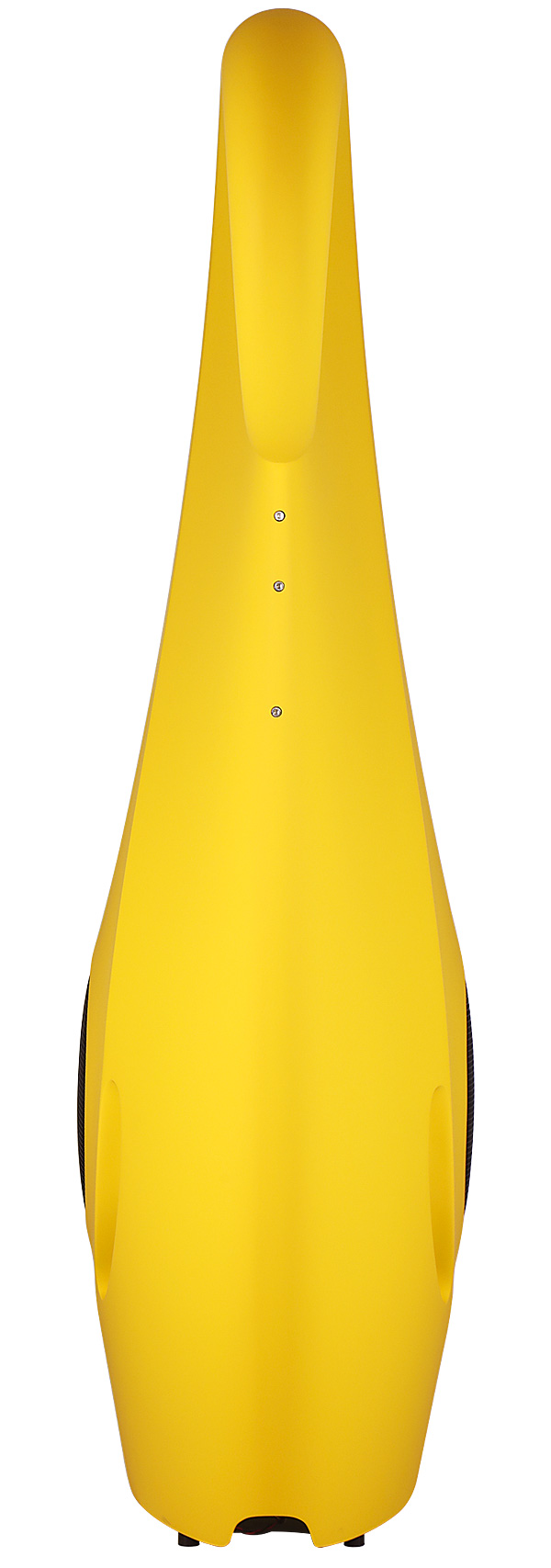
It certainly didn’t hinder my enjoyment of REM’s ‘Welcome To The Occupation’ [from Document; CBS/Sony CSCS 6085], which sounded nigh-on faultless. This late ’80s slice of indy-rock is quite compressed, and packed with multiple guitar overdubs, but I was struck by just how well the big Vivid picked its way through – like a hot knife through butter, it got right into the heart of the song and imparted that trademark raunchy Rickenbacker guitar sound with great skill.
There was also far more detail than expected, and it was all strung together in a wonderfully coherent and orderly way. The Giya 1S Spirit is also in its element with powerful, bass heavy music with strong dynamics; here the integrity and inertness of the cabinet is most evident, along with the quality of the drive units. The Congos’ ‘Days Chasing Days’ [from Congo Ashanti; Congos CD 21522] is a classic slice of late ’70s reggae – and a veritable virility test for a large loudspeaker, on account of the incredible tracts of bass that lock into a great groove with the drummer.
This speaker was able to mix it with the best of them, and even at very high volumes in PM’s listening room it coped heroically. Indeed I was more worried about the fate of the Ed’s double-glazing than the Spirit’s low frequency drivers. They grumbled and growled, yet showed no signs of strain, serving up a great groove that supported some prodigious dynamic contrasts.
A Grand Acoustic
The depth of the musical soundstage developed by the G1 Spirit is also very impressive. So when the recording has a deep and spacious acoustic, this loudspeaker can effortlessly convey the ‘architecture’ of the venue. For example, the opening movement from Mahler’s Symphony No 4 [Miah Persson/Ivan Fischer/Budapest Festival Orchestra; Channel Classics CCS SA 26109] did, indeed, sound cathedral-like in its scale and scope.
As if the boundaries of the listening room had been totally redrawn, this speaker drew images to the far left and right, and hung the acoustic way back into the distance beyond the plane of the loudspeakers. Simultaneously, the foreground bristled with the sound of the orchestra’s lead instruments, the ensemble sounding vibrant and natural, unsullied by driver or cabinet coloration.
The extended harmonics of brass and strings were left completely intact and possessed of a body and richness rarely experienced from loudspeakers at any price, while the rich timbre of the woodwind was a delight to behold. The Vivid Audio Giya G1 Spirit is surely one the most ‘complete’ loudspeakers ever to grace the hi-fi scene.
Hi-Fi News Verdict
This unusual looking loudspeaker is exceptionally accomplished in respect of power handling, dynamics, midrange transparency and stereo imaging while also knitting everything together in a wonderfully cohesive and natural way. The result is a delightful sound that yields so much more than the sum of its not inconsiderable parts. It is surely one of the greatest speakers currently on sale, at any price.
Description
Technical specifications
- Type 4-way, five-driver, reflex loaded floorstanding speaker
- Driver complement One 26mm metal dome tweeter with Tapered Tube loading; one 50mm metal dome midrange driver with Tapered Tube loading; one 125mm alloy/carbon diaphragm lower-mid driver with 75mm voice coil, two 225mm alloy diaphragm bass drivers with 100mm voice coil in 45mm gap
- Crossover frequencies 220Hz, 880Hz, 3.5kHz
- Frequency response + / -2dB 29–33,000 Hz
- Impedance 6 Ohms nominal, 3 Ohms minimum at 20 kHz
- Sensitivity 92dB @ 2.83 VRMS at 1 m on axis
- Dimensions (H×W×D) 1600 × 440 × 820mm
- Weight 67.4kg/each
- Finishes Piano black, Pearl white, Oyster matte plus premium colours
-
Price £82,500/pair









